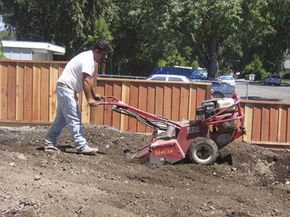Choosing a Lawn and Garden Tiller
When it comes time to choose a tiller, you first need to decide whether to purchase or rent. Most rental houses will let you till on an hourly, daily or weekly basis. A top-of-the-line, 12 horsepower rear-tined tiller will run you a little over $100 per day, or $20 per hour. A front-tined unit costs about half that amount. If you're tilling up a dirt front yard for grass seeding and you don't anticipate needing it beyond this job, renting may be your best option. If you're an avid gardener you might come out better to purchase.
Once you've figured this out, you need to determine what kind of tiller suits the job. You can decide this by figuring out how large an area you're tilling, how compacted the soil is and how hard you're willing to work. For the sake of simplicity, we'll break your choices down to three groups:
Advertisement
- Mini-tillers or cultivators
- Mid-size front-tined tillers
- Large rear-tined tillers
If you're tilling soil for a small herb garden and the dirt isn't hard and rocky, you can get by with a mini-tiller. Some weed eaters even come with a cultivating attachment that works just as well. If your soil is compact and rocky, a mini-tiller won't do, even if it's a small area. In this case, go with a mid-size front-tined tiller. A four horsepower model is easy to handle and maneuver in tight spaces. If you're tilling an entire yard for grass seeding or a large garden, then do yourself a favor and go with a rear-tined unit. If the ground is especially hard or rocky, you should also choose a model with counter-rotating tines. Large, rear-tined models are tough to turn, though, so only use it if you're working in an open area with plenty of room to maneuver.
Most tillers run on gasoline and start like your lawn mower does. Some large models have electric starters and the smallest cultivators may even run on electricity. If you cheap out and go with a front-tined tiller, be prepared to work harder. It will take more than one pass to do the tilling that a single pass with a rear-tined tiller would.
Approximate pricing for the three varieties is as follows:
- Mini-tiller -- $250 to $350
- Mid-size front-tined tiller -- $500 to $750
- Large rear-tined tiller -- $800 to $2,000
Front-tined tillers are more difficult to manage, but this is offset somewhat by its lighter weight. Rear-tined models can be easier to use, but they cost a lot more and take up much more room in your shed or garage -- something to consider. But even the largest tiller is no match for heavily compacted red-clay soil. While the machine does part of the work, you'll soon learn that it's backbreaking toil, no matter what kind of model you use. When it comes time to buy or rent, factor in all the above points and make your decision wisely. It's better to spend a little more money and save your muscles for the planting and harvesting. But if you're on a budget and working in tight spaces, you can't go wrong with a modest front-tined unit. If you're not into work at all and have money to burn, just hire a landscape crew to do the work for you.
Read on to learn about how to properly maintain your new tiller.
